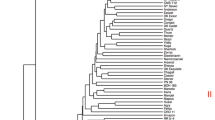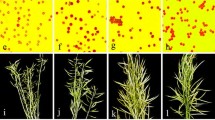Abstract
Different cultivars/transgenic lines of oilseed rape (Brassica napus) were crossed (as females) with different cultivars/populations of Brassica campestris. All cross combinations produced seed, with an average seed set per pollination of 9.8. Backcrossing of selected interspecific hybrids (as females) to B. campestris resulted in a much lower seed set, average 0.7 seed per pollination. In the single backcross progeny where a large enough population (92 plants) was obtained for analysis, 33 B. napus specific RAPD markers were investigated to determine the extent of transfer of oilseed rape genetic material into this population. Markers were transferred to the backcross generation with frequencies ranging from 26% to 91%. Almost all of the markers (30/33) were transferred in a frequency not significantly different from 50%. Analysis of the pairwise segregation of markers revealed that 23 markers could be assigned to six linkage groups, most probably reflecting six B. napus C-chromosomes. The presence of backcross plants with recombinant genotypes suggests that complex genetic processes can take place during interspecific hybridisation and backcrossing in these Brassica species. The implications of our results for the possible choice of integration sites of transgenes in oilseed rape are discussed.
Similar content being viewed by others
References
Armstrong KC, Keller WA (1982) Chromosome pairing in haploids of Brassica oleracea. Can J Genet Cytol 24:735–739
Attia T, Busso C, Robbelen G (1987) Digenomic triploids for an assessment of chromosome relationships in the cultivated diploid Brassica species. Genome 29:326–330
Chen BY, Heneen WK, Simonsen V (1990) Genetics of isozyme loci in Brassica campestris L. and in the progeny of a trigenomic hybrid between B. napus L. and B. campestris L. Genome 33:433–440
Chen BY, Simonsen V, Lannér-Herrera C, Heneen WK (1992) A Brassica campestris-alboglabra addition line and its use for gene mapping, intergenomic gene transfer and generation of trisomics. Theor Appl Genet 84:592–599
Chevre AM, This P, Eber F, Deschamps M, Renard M, Delseny M, Quiros CF (1991) Characterization of disomic addition lines Brassica napus-Brassica nigra by isozyme, fatty acid and RFLP markers. Theor Appl Genet 81:43–49
Dale PJ, Irwin JA, Scheffler JA (1993) The experimental and commercial release of transgenic crop plants. Plant Breed 111:1–22
Downey RK, Klassen AJ, Stringam GR (1980) Rapeseed and mustard. In: Fehr WR, Hadley HH (eds) Hybridization of crop plants. American Society of Agronomy and Crop Science Society of America, Madison, Wisconsin, pp 495–509
Edwards K, Johnstone C, Thompson C (1991) A simple and rapid method for the preparation of plant genomic DNA for PCR analysis. Nucleic Acids Res 19:1349
Hu J, Quiros CF (1991) Molecular and cytological evidence of deletions in alien chromosomes for two monosomic addition lines of Brassica campestris-oleracea. Theor Appl Genet 81:221–226
Jørgensen RB, Andersen B (1994) Spontaneous hybridization between oilseed rape (Brassica napus) and weedy B. campestris (Brassicaceae): a risk of growing genetically modified oilseed rape. Am J Bot 81:1620–1626
Jørgensen RB, Andersen B, Landbo L, Mikkelsen TR (1995) Spontaneous hybridisation between oilseed rape (Brassica napus) and weedy relatives. Acta Horticultura (in press)
Kramer MG, Redenbaugh K (1994) Commercialization of a tomato with an antisense polygalacturonase gene: The FLAVR SAVR tomato story. Euphytica 79:293–297
Krattiger A (1994) The field testing and commercialization of genetically engineered plants: a review of worldwide data (1986 to 1993/94). In: Krattiger A, Rosemarin A (eds) Biosafety for suslainable agricullure: sharing biotechnology regulatory experiences of the Western hemisphere. ISAA: Ithaca and SEI: Stockholm, pp 247–266
Lydiate D, Sharpe A, Lagercrantz U, Parkin I (1993) Mapping the Brassica genome. Outlook Agric 22:85–92
McGrath JM, Quiros CF (1990) Generation of alien chromosome addition lines from synthetic Brassica napus: morphology, cytology, fertility, and chromosome transmission. Genome 33:374–383
McGrath JM, Quiros CF, Harada JJ, Landry BS (1990) Identification of Brassica oleracea monosomic alien chromosome addition lines with molecular markers reveals extensive gene duplication. Mol Gen Genet 223:198–204
Nielsen G, Johansen HB (1986) Proposal for the identification of barley varieties based on the genotypes for 2 hordein and 39 isoenzyme loci of 47 reference varieties. Euphylica 35:717–728
Phillips RL (1981) Pollen and pollen tubes. In: Clark G (ed) Staining procedures. Williams and Wilkins, Baltimore. Maryland, pp 361–366
Pimentel RA (1979) Morphomelrics. The mullivariale analysis of biological data. Kendall/Hunt Publ, Ames, Iowa
Quiros CF, Hu J, Truco MJ (1994) DNA-based marker maps of Brassica. In: Phillips RL, Vasil IK (eds) DNA-based markers in plants. Kluwer Academic Publishers, The Netherlands, pp 199–222
Raybould AF, Gray AJ (1993) Genetically modified crops and hybridisation with wild relatives: a UK perspective. J Appl Ecol 30:199–219
Sambrook J, Fritsch EF, Maniatis T (1989) Molecular cloning: a laboratory manual, 2nd edn. Cold Spring Harbor Laboratory, Cold Spring Harbor, New York
Scheffler JA, Dale PJ (1994) Opportunities for gene transfer from transgenic oilseed rape (Brassica napus) to related species. Transgenic Res 3:263–278
Teutonico RA, Osborn TC (1994) Mapping of RFLP and quantitative trait loci in Brassica rapa and comparison to the linkage maps of B. napus, B. oleracea, and Arabidopsis thaliana. Theor Appl Genet 89:885–894
This P, Ochoa O, Quiros CF (1990) Dissection of the Brassica nigra genome by monosomic addition lines. Plant Breed 105:211–220
Toole EH, Toole VK (1939) Germination of some Brassica types at different temperatures. Proc Int Seed Testing Assoc 11:51–56
UN (1935) Genomic analysis in Brassica wilh special reference to the experimenlal formation of B. napus and peculiar mode of fertilization. Jpn J Bot 7:389–452
Williams JGK, Kubelik AR, Livak KL, Rafalski JA, Tingey SV (1991) DNA polymorphisms amplified by arbitrary primers are useful as genetic markers. Nucleic Acids Res 18:6531–6535
Author information
Authors and Affiliations
Additional information
Communicated by P. M. A. Tigerstedt
Rights and permissions
About this article
Cite this article
Mikkelsen, T.R., Jensen, J. & Jørgensen, R.B. Inheritance of oilseed rape (Brassica napus) RAPD markers in a backcross progeny with Brassica campestris . Theoret. Appl. Genetics 92, 492–497 (1996). https://doi.org/10.1007/BF00223698
Received:
Accepted:
Issue Date:
DOI: https://doi.org/10.1007/BF00223698




